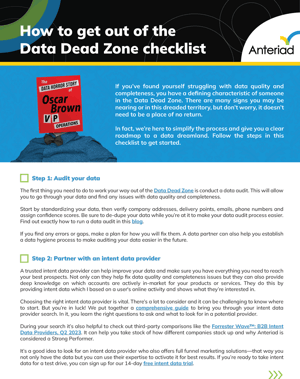How to Get Out of the Data Dead Zone
If you’ve found yourself struggling with data quality and completeness, you have a defining characteristic of someone in the Data Dead Zone. There are many signs you may be nearing or in this dreaded territory, but don’t worry, it doesn’t need to be a place of no return.
In fact, we’re here to simplify the process and give you a clear roadmap to a data dreamland. Follow the steps in this checklist to get started.
Step 1: Audit your data
The first thing you need to do to work your way out of the Data Dead Zone is conduct a data audit. This will allow you to go through your data and find any issues with data quality and completeness.
Start by standardizing your data, then verify company addresses, delivery points, emails, phone numbers and assign confidence scores. Be sure to de-dupe your data while you’re at it to make your data audit process easier. Find out exactly how to run a data audit in this blog.
If you find any errors or gaps, make a plan for how you will fix them. A data partner can also help you establish a data hygiene process to make auditing your data easier in the future.
Step 2: Partner with an intent data provider
A trusted intent data provider can help improve your data and make sure you have everything you need to reach your best prospects. Not only can they help fix data quality and completeness issues but they can also provide deep knowledge on which accounts are actively in-market for your products or services. They do this by providing intent data which I based on a user's online activity and shows what they’re interested in.
Choosing the right intent data provider is vital. There’s a lot to consider and it can be challenging to know where to start. But you’re in luck! We put together a comprehensive guide to bring you through your intent data provider search. In it, you learn the right questions to ask and what to look for in a potential provider.
During your search it’s also helpful to check out third-party comparisons like the Forrester Wave™: B2B Intent Data Providers, Q2 2023. It can help you take stock of how different companies stack up and why Anteriad is considered a Strong Performer.
It’s a good idea to look for an intent data provider who also offers full funnel marketing solutions—that way you not only have the data but you can use their expertise to activate it for best results.
Step 3: Add buying group scoring to your lead scoring methodology
Your next step is going to be to start focusing on buying groups. A buying group is a group of people with different job roles and functions who are all part of the purchasing process. Buying group scoring has proven to be an effective way to track who is part of a purchase decision and identify the key decision-makers within a target company.
You should consider adding buying groups to your scoring methodology because according to our recent research, these buying group users see improved metrics, increased revenue, are more likely to meet their goals, are more confident in their data and feel they can prove the value of their marketing efforts.
Start by looking for buying groups in your current customer base and then use this information to guide your buying group strategy. Check out this blog for some steps on how to get started. Once you have identified your buying groups you can start using buying group scoring to track their engagement and tailor your outreach and sales engagements.
Step 4: Explore B2C tactics
B2B buying behavior is changing. Recent research shows that B2B buyers are acting more like B2C buyers through the buyer’s journey. This is called consumerization and it’s going to change the way we all approach B2B marketing. You can read all about what this means in this blog.
This change in buying behavior means buyers are spending a lot more time researching independently online. So, you should focus more on digital channels. Social proof and review sites are a big consideration for B2B buyers today, so try to encourage any clients you have a good relationship with to champion you to their peers.
Integrated campaigns are a powerful strategy to reach the modern B2B buyer. This is because you're able to get your brand in front of them through multiple channels so you stay top of mind during their research. This can also help you ensure you reach them at the right time in their buying journey. You can build an integrated campaign by combining any variety of tactics like paid social, programmatic display, and targeted email campaigns to name a few.
Managed services are a great option here. If you work with a managed services marketing provider, they can help you build off of your current tactics to create a robust and effective integrated campaign. With their experience, you can trust they’ll be able to guide you in the best next move to grow your pipeline and move leads through your funnel.
Step 5: Keep up the good work and become a Data Hero
After you check off all of the previous steps on the checklist you are officially out of the Data Dead Zone! This also means you’re well on your way to becoming a Data Hero.
Data Heroes know they rea using the right data to build and convert their audiences because they can prove it in their pipeline. According to our recent study, only 27% of marketers fall into this mighty category, but those who do are outperforming their peers. Check out this eBook with a few actionable steps you can take to become one too.

